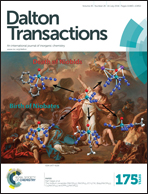Bis(dimethylsulfoxide)carbonateplatinum(ii), a new synthon for a low-impact, versatile synthetic route to anticancer Pt carboxylates†
Abstract
The work describes a new low-impact synthetic route to Pt(II)–carboxylate complexes, a class of compounds provided with established anticancer activity. The process is based on the ligand substitution on [PtCO3(Me2SO-S)2] (1), a new synthon that can be easily prepared in water with high yield, is stable as a solid, and is reactive in solution where all its ligands can be easily replaced. It reacts with acidic O-donors releasing CO2 as the only side-product, whose development also supplies a driving force toward the products. The substitution of carbonate led to new Pt-DMSO carboxylate complexes 2–4, while the total substitution of the ligands of complex 1 gave new Pt-phosphino carboxylates 5–9 in high yields. The X-ray crystal structures of complexes [Pt(D(−)-quinate-O,O′)(Me2SO-S)2] (3), [Pt(salicylate)(Me2SO-S)2] (4) and [Pt(salicylate)(PPh3)2] (6) were determined. The tests of the antiproliferative activity of complexes 1–9 on two human tumoral cell lines, A2780 (cisplatin-sensitive) and SKOV-3 (cisplatin-resistant), showed that the PTA (PTA = 1,3,5-triaza-7-phosphaadamantane) complexes 7–9 were the most active on both cell lines.


 Please wait while we load your content...
Please wait while we load your content...